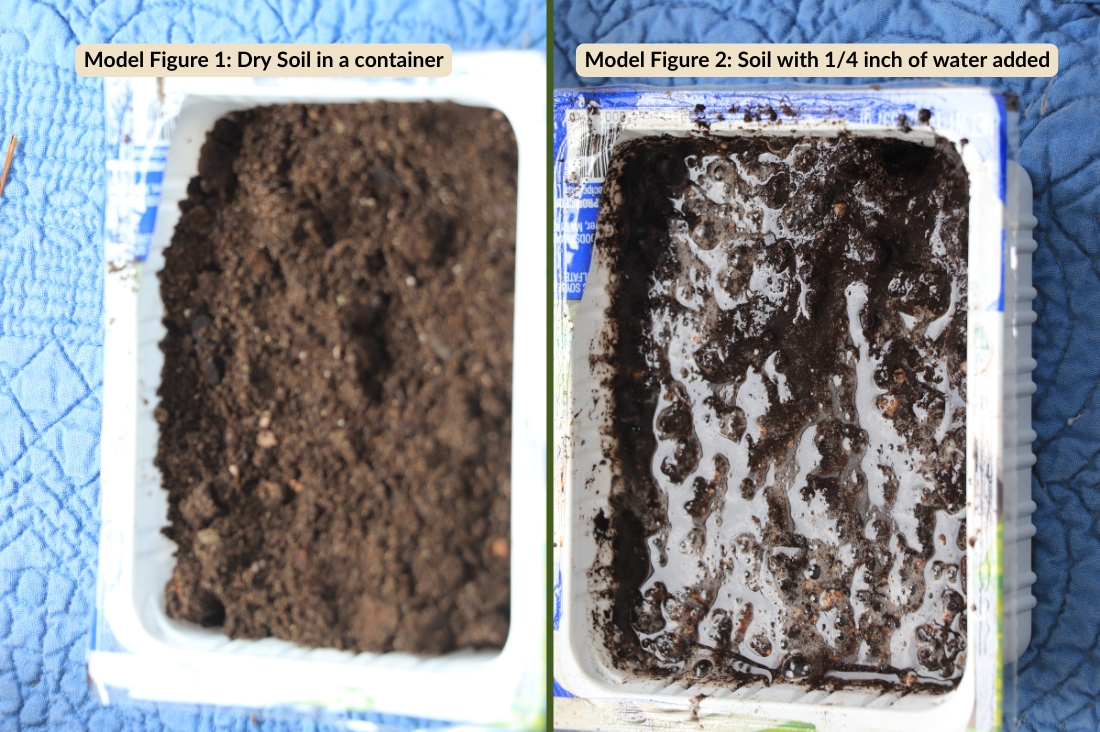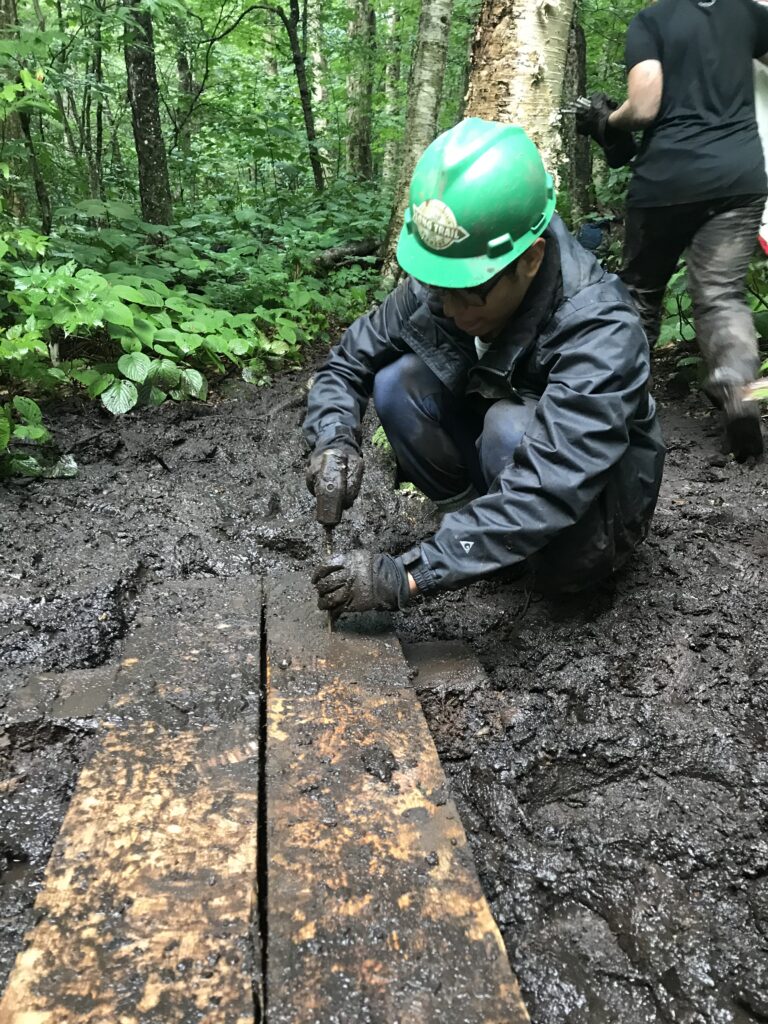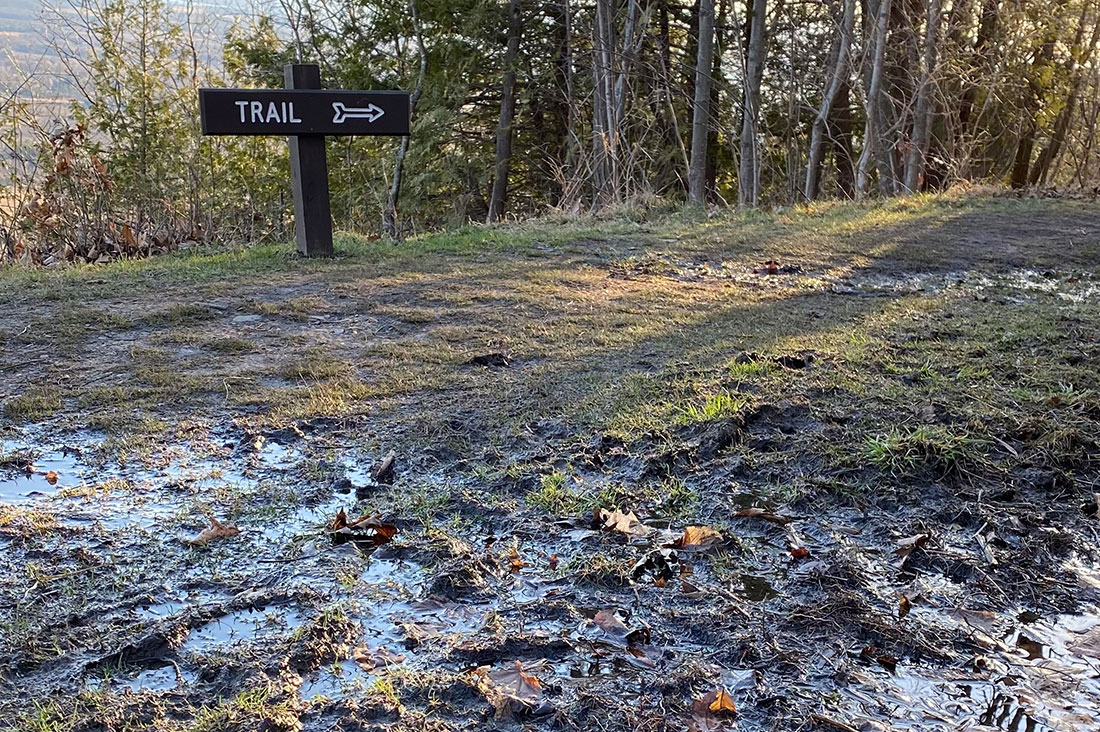Vermont — and especially the Long Trail — is known for being sort of muddy. We even have an official fifth season, “mud season.” Why is Vermont (sometimes known as “Vermud”) and the Long Trail so muddy? Why is the Long Trail so muddy? To answer, we asked Joe Bahr, newly minted author of the quarterly “Ask a Science Teacher” column. Joe is a long time GMC Member and volunteer, and has taught ecology and animal behavior at local colleges for the past 25 years. Have a nature question for Joe to answer? Submit it in the comments below or email Chloe Miller, [email protected]
Modeling Mud Season
Scientists like to create models to understand how the real world works. So I created a model of mud to see if it could illustrate why Vermont is so muddy – especially in spring.
My model was a small container that could hold two inches of soil. Into the soil I poured the equivalent of one-eighth of an inch of rain. The soil was a little moist but no mud. So I added another one-eighth of an inch of water and got the most marvelous muck that you ever saw. My model was a success!
 What can we tell from this simple model? First, to create mud you need to have something that holds the water and doesn’t let it percolate down through the soil. In mud season, that is the frozen ground – you couldn’t ask for a more impervious surface than that. There’s also bedrock just a few inches below the dirt surface on our high elevation mountain trails.
What can we tell from this simple model? First, to create mud you need to have something that holds the water and doesn’t let it percolate down through the soil. In mud season, that is the frozen ground – you couldn’t ask for a more impervious surface than that. There’s also bedrock just a few inches below the dirt surface on our high elevation mountain trails.
Perfect Conditions for Muddiness
On the Long Trail, several factors combine to create the conditions that prevent water from soaking into the ground or running off into the surrounding landscape, and mud season is a special case when forces combine to create that muddy mess.
One condition is very little soil. Our high elevation forests often have six inches or less of soil above bedrock. So any rain that falls has to be absorbed by six inches or less of soil. Scaling my two-inch model up to six inches of soil would mean that only about a half-inch of rain would start creating a problem with mud. Since the mountaintops also receive about fifty percent more rain than the valleys where we live and work, that means that a mere one-third of an inch of rain down here would be a half-inch of rain above 3,000 feet – enough to create a problem with mud.
Mountains get more snow than the lowlands and less of it melts during warm spells. On average, the temperature drops by three degrees for every one-thousand-foot rise in elevation. So when it is 45 degrees at the Green Mountain Club headquarters, it may be only 32 degrees on the mountaintops, and the ground may still be frozen solid.
As of March 26, 2023, the Mount Mansfield snow stake reflects 78 inches of snow – higher than average at this point in the season, given the late arrival of winter. With an average of five or six feet of snow at many higher elevations and with at least an inch of water in a foot of melted snow, that means the Long Trail is trying to cope with a half-foot of water as snowmelt as well as any rain that falls during April and May. In April and May, trees haven’t regained their full set of leaves, which means they can absorb less water as well. The combined snowmelt and rainfall means that there are more inches of water than soil on the trail. This makes the trails not only very muddy but also very susceptible to being damaged.
A particular problem with mud at high elevations occurs on ridgelines that have stretches of flat terrain. On flat terrain, water simply pools up to create mud even in the middle of summer. Sloping terrain doesn’t have this problem because any excess water can flow downhill until it meets a flat area (though too much slope means water also washes away the soil, eroding the trail). This also explains why a trail that slabs a hillside may be muddy even though the sloping hillside is dry: the small flat area that is the trail holds the moisture flowing down from above. That’s why GMC employs sustainable trail design in our annual rehab projects, to implement drainage structures and correct some of the impacts of water flow and erosion.

Another condition is the type of soil. Vermont is home to a lot of soil with a very high clay content, which drains much more poorly than soil with a sandier makeup, for example. So clay-laden soil holds a massive amount of water. Soil that contains a lot of sand drains much better than a soil with a lot of clay. So a clay soil on a slope is also much more likely to be muddy.
How to Hike in Muddy Conditions

What is the solution? During mud season, stay off the muddy trails as much as possible, especially those at high elevations or at a particularly pitched slope. Seek out lower elevations and durable surfaces – Vermont is home to thousands of beautiful dirt roads to wander.
Muddy conditions exist year-round, and we’re starting to see mud-season-esque conditions mid-winter and mid-summer, with more freeze-thaw cycles and more intense rainstorms. The best thing you can do is wait until several days after the rain stops falling. In typically warm summer weather, water will evaporate within a few days and the trails will have less mud than the day after a storm. Not only is that good for you, but it also helps the trail. If you must go hiking (we get it!) and face muddy conditions, walk directly through the mud. It limits trail widening and trampling the vegetation on the edges of a trail.
We think fondly of our “Vermud,” and there are several reasons why Vermont gets so muddy. Understanding the mud, and how you can best hike through it, is a key step to being a responsible hiker.
Ask a Science Teacher is a new column that will run in the quarterly Long Trail News as well as online. What questions do you have for our science teacher, Joe Bahr? Submit them via comment below or email to [email protected]



















So is it mud season now? should we stay off trails?
Great Question! Currently, March 29, 2023, most mountain trails still have solid snow cover. You may find muddy conditions on southern facing slopes and lower elevations. Trail are not yet officially “closed” for mud season – though that will likely happen within the next week. No matter the official season, you should be prepared to turn around OR walk directly through the mud (not around it) if you encounter muddy conditions – those are the best ways to protect the trail. Stay tuned for more info on mud season coming soon.